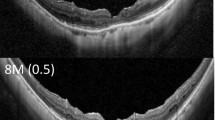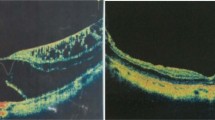Abstract
Purpose
To explore whether the efficacy of fovea-sparing internal limiting membrane peeling (FS-ILMP) is better than that of complete internal limiting membrane peeling (ILMP).
Methods
This retrospective clinical study included 34 cases (34 eyes) with myopic traction maculopathy collected from June 2017 to February 2019. Twenty-three-gauge (23-G) pars plana vitrectomy (23G PPV) was performed on all patients. In the FS-ILMP group, 18 eyes retained the internal limiting membrane (ILM) of about 1 to 1.5 papillary diameter centered on fovea centralis, while in the standard ILMP group, the ILM was completely removed from 16 eyes. The best corrected visual acuity (BCVA), central foveal thickness (CFT), and other indexes were collected before and 6 months after surgery.
Results
There was no significant difference in baseline clinical characteristics between the two groups. CFT and BCVA were significantly improved in both FS-ILMP and standard ILMP group, but the postoperative BCVA of the FS-ILMP group was significantly better than that of the standard ILMP group (P < 0.001). Two cases of subretinal effusion in macula were recorded in the FS-ILMP group, and three eyes in the standard ILMP group developed macular holes after surgery. Although both treatments relieved the mechanical traction of macular fovea, the patients in the FS-ILMP group showed better clinical outcomes in various aspects.
Conclusion
These results improved our understanding of the clinical application of vitrectomy combined with preservation of ILM upon the fovea centralis, which might lay a foundation for in-depth study on the treatment of myopic traction maculopathy.


Similar content being viewed by others
References
Verkicharla PK, Ohno-Matsui K, Saw SM (2015) Current and predicted demographics of high myopia and an update of its associated pathological changes. Ophthalmic Physiol Opt 35:465–475. https://doi.org/10.1111/opo.12238
Chen SJ, Cheng CY, Li AF, Peng KL, Chou P, Chiou SH, Hsu WM (2012) Prevalence and associated risk factors of myopic maculopathy in elderly Chinese: the Shihpai eye study. Invest Ophthalmol Vis Sci 53:4868–4873. https://doi.org/10.1167/iovs.12-9919
Hsu WM, Cheng CY, Liu JH, Tsai SY, Chou P (2004) Prevalence and causes of visual impairment in an elderly Chinese population in Taiwan: the Shihpai Eye Study. Ophthalmology 111:62–69. https://doi.org/10.1016/j.ophtha.2003.05.011
Panozzo G, Mercanti A (2007) Vitrectomy for myopic traction maculopathy. Arch Ophthalmol 125:767–772. https://doi.org/10.1001/archopht.125.6.767
Frisina R, Gius I, Palmieri M, Finzi A, Tozzi L, Parolini B (2020) Myopic traction maculopathy: diagnostic and management strategies. Clin Ophthalmol 14:3699–3708. https://doi.org/10.2147/opth.s237483
Gómez-Resa M, Burés-Jelstrup A, Mateo C (2014) Myopic traction maculopathy. Dev Ophthalmol 54:204–212. https://doi.org/10.1159/000360468
Ruiz-Medrano J, Montero JA, Flores-Moreno I, Arias L, García-Layana A, Ruiz-Moreno JM (2019) Myopic maculopathy: current status and proposal for a new classification and grading system (ATN). Prog Retin Eye Res 69:80–115. https://doi.org/10.1016/j.preteyeres.2018.10.005
Duan TQ, Tan W, Yang J, Li FL, Xiong SQ, Wang XG, Xu HZ (2020) Morphological characteristics predict postoperative outcomes after vitrectomy in myopic traction maculopathy patients. Ophthalmic Surg Lasers Imaging Retina 51:574–582. https://doi.org/10.3928/23258160-20201005-05
Kim CY, Kim MS, Kim KL, Woo SJ, Park KH (2020) Prognostic factors related with surgical outcome of vitrectomy in myopic traction maculopathy. Korean J Ophthalmol 34:67–75. https://doi.org/10.3341/kjo.2019.0115
Wu J, Xu Q, Luan J (2020) Vitrectomy with fovea-sparing ILM peeling versus total ILM peeling for myopic traction maculopathy: a meta-analysis. Eur J Ophthalmol 1120672120970111. https://doi.org/10.1177/1120672120970111
Kobayashi H, Kishi S (2003) Vitreous surgery for highly myopic eyes with foveal detachment and retinoschisis. Ophthalmology 110:1702–1707. https://doi.org/10.1016/s0161-6420(03)00714-0
Ho TC, Yang CM, Huang JS, Yang CH, Yeh PT, Chen TC, Ho A, Chen MS (2014) Long-term outcome of foveolar internal limiting membrane nonpeeling for myopic traction maculopathy. Retina 34:1833–1840. https://doi.org/10.1097/iae.0000000000000149
Iwasaki M, Miyamoto H, Okushiba U, Imaizumi H (2020) Fovea-sparing internal limiting membrane peeling versus complete internal limiting membrane peeling for myopic traction maculopathy. Jpn J Ophthalmol 64:13–21. https://doi.org/10.1007/s10384-019-00696-1
Tadayoni R, Svorenova I, Erginay A, Gaudric A, Massin P (2012) Decreased retinal sensitivity after internal limiting membrane peeling for macular hole surgery. Br J Ophthalmol 96:1513–1516. https://doi.org/10.1136/bjophthalmol-2012-302035
Lee CL, Wu WC, Chen KJ, Chiu LY, Wu KY, Chang YC (2017) Modified internal limiting membrane peeling technique (maculorrhexis) for myopic foveoschisis surgery. Acta Ophthalmol 95:e128–e131. https://doi.org/10.1111/aos.13115
Elwan MM, Abd Elghafar AE, Hagras SM, Abou Samra WA, Saleh SM (2019) Long-term outcome of internal limiting membrane peeling with and without foveal sparing in myopic foveoschisis. Eur J Ophthalmol 29:69–74. https://doi.org/10.1177/1120672117750059
Shimada N, Sugamoto Y, Ogawa M, Takase H, Ohno-Matsui K (2012) Fovea-sparing internal limiting membrane peeling for myopic traction maculopathy. Am J Ophthalmol 154:693–701. https://doi.org/10.1016/j.ajo.2012.04.013
Kumagai K, Furukawa M, Ogino N, Larson E (2010) Factors correlated with postoperative visual acuity after vitrectomy and internal limiting membrane peeling for myopic foveoschisis. Retina 30:874–880. https://doi.org/10.1097/IAE.0b013e3181c703fc
Kodjikian L, Richter T, Halberstadt M, Beby F, Flueckiger F, Boehnke M, Garweg JG (2005) Toxic effects of indocyanine green, infracyanine green, and trypan blue on the human retinal pigmented epithelium. Graefes Arch Clin Exp Ophthalmol 243:917–925. https://doi.org/10.1007/s00417-004-1121-6
Gandorfer A, Haritoglou C, Kampik A (2008) Toxicity of indocyanine green in vitreoretinal surgery. Dev Ophthalmol 42:69–81. https://doi.org/10.1159/000138974
Awan A, Yang YC (2006) Shellfish allergy: a contraindication for fundus fluorescein angiography; misconception or reality. Eye (Lond) 20:1383–1384. https://doi.org/10.1038/sj.eye.6702220
Su Z, Ye P, Teng Y, Zhang L, Shu X (2012) Adverse reaction in patients with drug allergy history after simultaneous intravenous fundus fluorescein angiography and indocyanine green angiography. J Ocul Pharmacol Ther 28:410–413. https://doi.org/10.1089/jop.2011.0221
Kornblau IS, El-Annan JF (2019) Adverse reactions to fluorescein angiography: a comprehensive review of the literature. Surv Ophthalmol 64:679–693. https://doi.org/10.1016/j.survophthal.2019.02.004
Shiraki N, Wakabayashi T, Ikuno Y, Matsumura N, Sato S, Sakaguchi H, Nishida K (2020) fovea-sparing versus standard internal limiting membrane peeling for myopic traction maculopathy: a study of 102 consecutive cases. Ophthalmol Retina 4:1170–1180. https://doi.org/10.1016/j.oret.2020.05.016
Wang L, Wang Y, Li Y, Yan Z, Li Y, Lu L, Lu T, Wang X, Zhang S, Shang Y (2019) Comparison of effectiveness between complete internal limiting membrane peeling and internal limiting membrane peeling with preservation of the central fovea in combination with 25G vitrectomy for the treatment of high myopic foveoschisis. Medicine 98:e14710. https://doi.org/10.1097/md.0000000000014710
Author information
Authors and Affiliations
Contributions
WX and JJ wrote the manuscript and interpreted the data. LJ, WL, and YG contributed to drafting of the manuscript and data analysis. YX conceived and designed the work. All the authors read and approved the final version of the submitted article.
Corresponding author
Ethics declarations
Ethics approval
The studies involving human participants were reviewed and approved by the ethics committee of General Hospital of Xinjiang Military Region. The patients/participants provided their written informed consent to participate in this study. Written informed consent was obtained from the individual(s) for the publication of any potentially identifiable images or data included in this article. The study protocol of this study conforms to the ethical guidelines of the 1975 Declaration of Helsinki.
Conflict of interest
The authors declare no competing interests.
Additional information
Publisher's note
Springer Nature remains neutral with regard to jurisdictional claims in published maps and institutional affiliations.
Wen-Jian Xin and Ji-Ze Jiang contributed equally to this work and share first authorship.
Supplementary Information
Below is the link to the electronic supplementary material.
Rights and permissions
About this article
Cite this article
Xin, WJ., Jiang, JZ., Ji, LB. et al. Efficiency comparison with fovea-sparing internal limiting membrane peeling and complete internal limiting membrane peeling for treating myopic traction maculopathy . Graefes Arch Clin Exp Ophthalmol 260, 73–81 (2022). https://doi.org/10.1007/s00417-021-05320-y
Received:
Revised:
Accepted:
Published:
Issue Date:
DOI: https://doi.org/10.1007/s00417-021-05320-y




